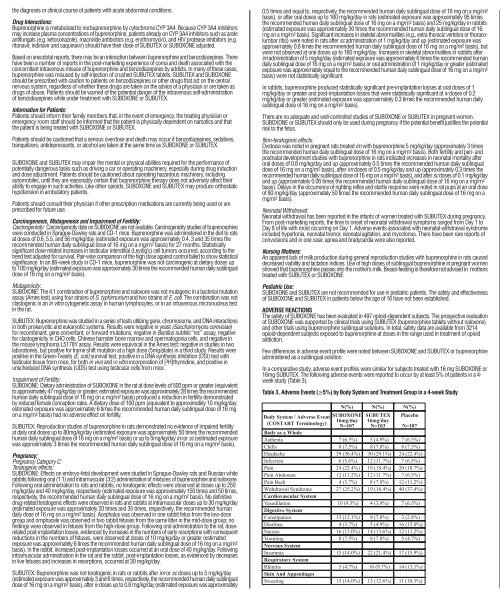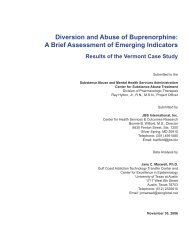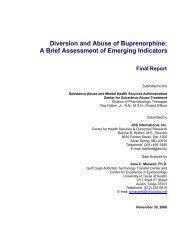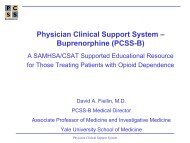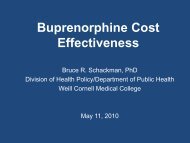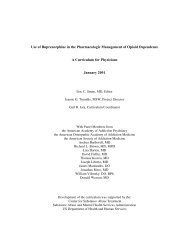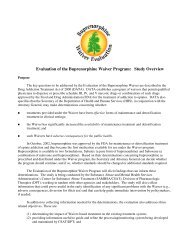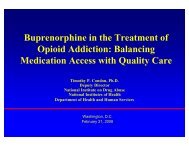Subutex Discontinued - Buprenorphine
Subutex Discontinued - Buprenorphine
Subutex Discontinued - Buprenorphine
Create successful ePaper yourself
Turn your PDF publications into a flip-book with our unique Google optimized e-Paper software.
the diagnosis or clinical course of patients with acute abdominal conditions.<br />
Drug Interactions:<br />
<strong>Buprenorphine</strong> is metabolized to norbuprenorphine by cytochrome CYP 3A4. Because CYP 3A4 inhibitors<br />
may increase plasma concentrations of buprenorphine, patients already on CYP 3A4 inhibitors such as azole<br />
antifungals (e.g. ketoconazole), macrolide antibiotics (e.g. erythromycin), and HIV protease inhibitors (e.g.<br />
ritonavir, indinavir and saquinavir) should have their dose of SUBUTEX or SUBOXONE adjusted.<br />
Based on anecdotal reports, there may be an interaction between buprenorphine and benzodiazepines. There<br />
have been a number of reports in the post-marketing experience of coma and death associated with the<br />
concomitant intravenous misuse of buprenorphine and benzodiazepines by addicts. In many of these cases,<br />
buprenorphine was misused by self-injection of crushed SUBUTEX tablets. SUBUTEX and SUBOXONE<br />
should be prescribed with caution to patients on benzodiazepines or other drugs that act on the central<br />
nervous system, regardless of whether these drugs are taken on the advice of a physician or are taken as<br />
drugs of abuse. Patients should be warned of the potential danger of the intravenous self-administration<br />
of benzodiazepines while under treatment with SUBOXONE or SUBUTEX.<br />
Information for Patients:<br />
Patients should inform their family members that, in the event of emergency, the treating physician or<br />
emergency room staff should be informed that the patient is physically dependent on narcotics and that<br />
the patient is being treated with SUBOXONE or SUBUTEX.<br />
Patients should be cautioned that a serious overdose and death may occur if benzodiazepines, sedatives,<br />
tranquilizers, antidepressants, or alcohol are taken at the same time as SUBOXONE or SUBUTEX.<br />
SUBOXONE and SUBUTEX may impair the mental or physical abilities required for the performance of<br />
potentially dangerous tasks such as driving a car or operating machinery, especially during drug induction<br />
and dose adjustment. Patients should be cautioned about operating hazardous machinery, including<br />
automobiles, until they are reasonably certain that buprenorphine therapy does not adversely affect their<br />
ability to engage in such activities. Like other opioids, SUBOXONE and SUBUTEX may produce orthostatic<br />
hypotension in ambulatory patients.<br />
Patients should consult their physician if other prescription medications are currently being used or are<br />
prescribed for future use.<br />
Carcinogenesis, Mutagenesis and Impairment of Fertility:<br />
Carcinogenicity: Carcinogenicity data on SUBOXONE are not available. Carcinogenicity studies of buprenorphine<br />
were conducted in Sprague-Dawley rats and CD-1 mice. <strong>Buprenorphine</strong> was administered in the diet to rats<br />
at doses of 0.6, 5.5, and 56 mg/kg/day (estimated exposure was approximately 0.4, 3 and 35 times the<br />
recommended human daily sublingual dose of 16 mg on a mg/m 2 basis) for 27 months. Statistically<br />
significant dose-related increases in testicular interstitial (Leydig’s) cell tumors occurred, according to the<br />
trend test adjusted for survival. Pair-wise comparison of the high dose against control failed to show statistical<br />
significance. In an 86-week study in CD-1 mice, buprenorphine was not carcinogenic at dietary doses up<br />
to 100 mg/kg/day (estimated exposure was approximately 30 times the recommended human daily sublingual<br />
dose of 16 mg on a mg/m 2 basis).<br />
Mutagenicity:<br />
SUBOXONE: The 4:1 combination of buprenorphine and naloxone was not mutagenic in a bacterial mutation<br />
assay (Ames test) using four strains of S. typhimurium and two strains of E. coli. The combination was not<br />
clastogenic in an in vitro cytogenetic assay in human lymphocytes, or in an intravenous micronucleus test<br />
in the rat.<br />
SUBUTEX: <strong>Buprenorphine</strong> was studied in a series of tests utilizing gene, chromosome, and DNA interactions<br />
in both prokaryotic and eukaryotic systems. Results were negative in yeast (Saccharomyces cerevisiae)<br />
for recombinant, gene convertant, or forward mutations; negative in Bacillus subtilis “rec” assay, negative<br />
for clastogenicity in CHO cells, Chinese hamster bone marrow and spermatogonia cells, and negative in<br />
the mouse lymphoma L5178Y assay. Results were equivocal in the Ames test: negative in studies in two<br />
laboratories, but positive for frame shift mutation at a high dose (5mg/plate) in a third study. Results were<br />
positive in the Green-Tweets (E. coli) survival test, positive in a DNA synthesis inhibition (DSI) test with<br />
testicular tissue from mice, for both in vivo and in vitro incorporation of [ 3H]thymidine, and positive in<br />
unscheduled DNA synthesis (UDS) test using testicular cells from mice.<br />
Impairment of Fertility:<br />
SUBOXONE: Dietary administration of SUBOXONE in the rat at dose levels of 500 ppm or greater (equivalent<br />
to approximately 47 mg/kg/day or greater; estimated exposure was approximately 28 times the recommended<br />
human daily sublingual dose of 16 mg on a mg/m 2 basis) produced a reduction in fertility demonstrated<br />
by reduced female conception rates. A dietary dose of 100 ppm (equivalent to approximately 10 mg/kg/day;<br />
estimated exposure was approximately 6 times the recommended human daily sublingual dose of 16 mg<br />
on a mg/m 2 basis) had no adverse effect on fertility.<br />
SUBUTEX: Reproduction studies of buprenorphine in rats demonstrated no evidence of impaired fertility<br />
at daily oral doses up to 80mg/kg/day (estimated exposure was approximately 50 times the recommended<br />
human daily sublingual dose of 16 mg on a mg/m 2 basis) or up to 5mg/kg/day im or sc (estimated exposure<br />
was approximately 3 times the recommended human daily sublingual dose of 16 mg on a mg/m 2 basis).<br />
Pregnancy;<br />
Pregnancy Category C:<br />
Teratogenic effects:<br />
SUBOXONE: Effects on embryo-fetal development were studied in Sprague-Dawley rats and Russian white<br />
rabbits following oral (1:1) and intramuscular (3:2) administration of mixtures of buprenorphine and naloxone.<br />
Following oral administration to rats and rabbits, no teratogenic effects were observed at doses up to 250<br />
mg/kg/day and 40 mg/kg/day, respectively (estimated exposure was approximately 150 times and 50 times,<br />
respectively, the recommended human daily sublingual dose of 16 mg on a mg/m2 basis). No definitive<br />
drug-related teratogenic effects were observed in rats and rabbits at intramuscular doses up to 30 mg/kg/day<br />
(estimated exposure was approximately 20 times and 35 times, respectively, the recommended human<br />
daily dose of 16 mg on a mg/m2 basis). Acephalus was observed in one rabbit fetus from the low-dose<br />
group and omphacele was observed in two rabbit fetuses from the same litter in the mid-dose group; no<br />
findings were observed in fetuses from the high-dose group. Following oral administration to the rat, doserelated<br />
post-implantation losses, evidenced by increases in the numbers of early resorptions with consequent<br />
reductions in the numbers of fetuses, were observed at doses of 10 mg/kg/day or greater (estimated<br />
exposure was approximately 6 times the recommended human daily sublingual dose of 16 mg on a mg/m2 basis). In the rabbit, increased post-implantation losses occurred at an oral dose of 40 mg/kg/day. Following<br />
intramuscular administration in the rat and the rabbit, post-implantation losses, as evidenced by decreases<br />
in live fetuses and increases in resorptions, occurred at 30 mg/kg/day.<br />
SUBUTEX: <strong>Buprenorphine</strong> was not teratogenic in rats or rabbits after im or sc doses up to 5 mg/kg/day<br />
(estimated exposure was approximately 3 and 6 times, respectively, the recommended human daily sublingual<br />
dose of 16 mg on a mg/m2 basis), after iv doses up to 0.8 mg/kg/day (estimated exposure was approximately<br />
0.5 times and equal to, respectively, the recommended human daily sublingual dose of 16 mg on a mg/m2 basis), or after oral doses up to 160 mg/kg/day in rats (estimated exposure was approximately 95 times<br />
the recommended human daily sublingual dose of 16 mg on a mg/m2 basis) and 25 mg/kg/day in rabbits<br />
(estimated exposure was approximately 30 times the recommended human daily sublingual dose of 16<br />
mg on a mg/m2 basis). Significant increases in skeletal abnormalities (e.g., extra thoracic vertebra or thoracolumbar<br />
ribs) were noted in rats after sc administration of 1 mg/kg/day and up (estimated exposure was<br />
approximately 0.6 times the recommended human daily sublingual dose of 16 mg on a mg/m2 basis), but<br />
were not observed at oral doses up to 160 mg/kg/day. Increases in skeletal abnormalities in rabbits after<br />
im administration of 5 mg/kg/day (estimated exposure was approximately 6 times the recommended human<br />
daily sublingual dose of 16 mg on a mg/m2 basis) or oral administration of 1 mg/kg/day or greater (estimated<br />
exposure was approximately equal to the recommended human daily sublingual dose of 16 mg on a mg/m2 basis) were not statistically significant.<br />
In rabbits, buprenorphine produced statistically significant pre-implantation losses at oral doses of 1<br />
mg/kg/day or greater and post-implantation losses that were statistically significant at iv doses of 0.2<br />
mg/kg/day or greater (estimated exposure was approximately 0.3 times the recommended human daily<br />
sublingual dose of 16 mg on a mg/m2 basis).<br />
There are no adequate and well-controlled studies of SUBOXONE or SUBUTEX in pregnant women.<br />
SUBOXONE or SUBUTEX should only be used during pregnancy if the potential benefit justifies the potential<br />
risk to the fetus.<br />
Non-teratogenic effects.<br />
Dystocia was noted in pregnant rats treated im with buprenorphine 5 mg/kg/day (approximately 3 times<br />
the recommended human daily sublingual dose of 16 mg on a mg/m 2 basis). Both fertility and peri- and<br />
postnatal development studies with buprenorphine in rats indicated increases in neonatal mortality after<br />
oral doses of 0.8 mg/kg/day and up (approximately 0.5 times the recommended human daily sublingual<br />
dose of 16 mg on a mg/m 2 basis), after im doses of 0.5 mg/kg/day and up (approximately 0.3 times the<br />
recommended human daily sublingual dose of 16 mg on a mg/m 2 basis), and after sc doses of 0.1 mg/kg/day<br />
and up (approximately 0.06 times the recommended human daily sublingual dose of 16 mg on a mg/m 2<br />
basis). Delays in the occurrence of righting reflex and startle response were noted in rat pups at an oral dose<br />
of 80 mg/kg/day (approximately 50 times the recommended human daily sublingual dose of 16 mg on a<br />
mg/m 2 basis).<br />
Neonatal Withdrawal:<br />
Neonatal withdrawal has been reported in the infants of women treated with SUBUTEX during pregnancy.<br />
From post-marketing reports, the time to onset of neonatal withdrawal symptoms ranged from Day 1 to<br />
Day 8 of life with most occurring on Day 1. Adverse events associated with neonatal withdrawal syndrome<br />
included hypertonia, neonatal tremor, neonatal agitation, and myoclonus. There have been rare reports of<br />
convulsions and in one case, apnea and bradycardia were also reported.<br />
Nursing Mothers:<br />
An apparent lack of milk production during general reproduction studies with buprenorphine in rats caused<br />
decreased viability and lactation indices. Use of high doses of sublingual buprenorphine in pregnant women<br />
showed that buprenorphine passes into the mother’s milk. Breast-feeding is therefore not advised in mothers<br />
treated with SUBUTEX or SUBOXONE.<br />
Pediatric Use:<br />
SUBOXONE and SUBUTEX are not recommended for use in pediatric patients. The safety and effectiveness<br />
of SUBOXONE and SUBUTEX in patients below the age of 16 have not been established.<br />
ADVERSE REACTIONS<br />
The safety of SUBOXONE has been evaluated in 497 opioid-dependent subjects. The prospective evaluation<br />
of SUBOXONE was supported by clinical trials using SUBUTEX (buprenorphine tablets without naloxone)<br />
and other trials using buprenorphine sublingual solutions. In total, safety data are available from 3214<br />
opioid-dependent subjects exposed to buprenorphine at doses in the range used in treatment of opioid<br />
addiction.<br />
Few differences in adverse event profile were noted between SUBOXONE and SUBUTEX or buprenorphine<br />
administered as a sublingual solution.<br />
In a comparative study, adverse event profiles were similar for subjects treated with 16 mg SUBOXONE or<br />
16mg SUBUTEX. The following adverse events were reported to occur by at least 5% of patients in a 4week<br />
study (Table 3).<br />
Table 3. Adverse Events (≥5%) by Body System and Treatment Group in a 4-week Study<br />
<br />
<br />
<br />
<br />
<br />
<br />
<br />
<br />
<br />
<br />
<br />
<br />
<br />
<br />
<br />
<br />
<br />
<br />
<br />
<br />
<br />
<br />
<br />
<br />
<br />
<br />
<br />
<br />
<br />
<br />
<br />
<br />
<br />
<br />
The adverse event profile of buprenorphine was also characterized in the dose-controlled study of<br />
buprenorphine solution, over a range of doses in four months of treatment. Table 4 shows adverse events<br />
reported by at least 5% of subjects in any dose group in the dose-controlled study.<br />
Table 4. Adverse Events (≥5%) by Body System and Treatment Group in a 16-week Study<br />
<br />
<br />
<br />
<br />
<br />
<br />
<br />
<br />
<br />
<br />
<br />
<br />
<br />
<br />
<br />
<br />
<br />
<br />
<br />
<br />
<br />
<br />
<br />
<br />
<br />
<br />
<br />
<br />
<br />
<br />
<br />
<br />
<br />
<br />
<br />
<br />
<br />
*Sublingual solution. Doses in this table cannot necessarily be delivered in tablet form, but for comparison purposes:<br />
“Very low” dose (1mg solution) would be less than a tablet dose of 2 mg<br />
“Low” dose (4mg solution) approximates a 6 mg tablet dose<br />
“Moderate” dose (8mg solution) approximates a 12 mg tablet dose<br />
“High” dose (16mg solution) approximates a 24 mg tablet dose<br />
DRUG ABUSE AND DEPENDENCE<br />
SUBOXONE and SUBUTEX are controlled as Schedule III narcotics under the Controlled Substances Act.<br />
<strong>Buprenorphine</strong> is a partial agonist at the mu-opioid receptor and chronic administration produces dependence<br />
of the opioid type, characterized by moderate withdrawal upon abrupt discontinuation or rapid taper. The<br />
withdrawal syndrome is milder than seen with full agonists, and may be delayed in onset (SEE WARNINGS)<br />
Neonatal withdrawal has been reported in the infants of women treated with SUBUTEX during pregnancy<br />
(See PRECAUTIONS)<br />
SUBOXONE contains naloxone and if misused parenterally, is highly likely to produce marked and intense<br />
withdrawal symptoms in subjects dependent on other opioid agonists.<br />
OVERDOSAGE<br />
Manifestations:<br />
Manifestations of acute overdose include pinpoint pupils, sedation, hypotension, respiratory depression<br />
and death.<br />
Treatment:<br />
The respiratory and cardiac status of the patient should be monitored carefully. In the event of depression<br />
of respiratory or cardiac function, primary attention should be given to the re-establishment of adequate<br />
respiratory exchange through provision of a patent airway and institution of assisted or controlled ventilation.<br />
Oxygen, intravenous fluids, vasopressors, and other supportive measures should be employed as indicated.<br />
IN THE CASE OF OVERDOSE, THE PRIMARY MANAGEMENT SHOULD BE THE RE-ESTABLISHMENT OF<br />
ADEQUATE VENTILATION WITH MECHANICAL ASSISTANCE OF RESPIRATION, IF REQUIRED. NALOXONE<br />
MAY NOT BE EFFECTIVE IN REVERSING ANY RESPIRATORY DEPRESSION PRODUCED BY<br />
BUPRENORPHINE.<br />
High doses of naloxone hydrochloride, 10-35 mg/70 kg may be of limited value in the management of<br />
buprenorphine overdose. Doxapram (a respiratory stimulant) also has been used.<br />
DOSAGE AND ADMINISTRATION<br />
SUBUTEX or SUBOXONE is administered sublingually as a single daily dose in the range of 12 to 16mg/<br />
day. When taken sublingually, SUBOXONE and SUBUTEX have similar clinical effects and are interchangeable.<br />
There are no adequate and well-controlled studies using SUBOXONE as initial medication. SUBUTEX contains<br />
no naloxone and is preferred for use during induction. Following induction, SUBOXONE, due to the presence<br />
of naloxone, is preferred when clinical use includes unsupervised administration. The use of SUBUTEX for<br />
unsupervised administration should be limited to those patients who cannot tolerate SUBOXONE, for example<br />
those patients who have been shown to be hypersensitive to naloxone.<br />
Method of administration:<br />
SUBOXONE and SUBUTEX tablets should be placed under the tongue until they are dissolved.<br />
For doses requiring the use of more than two tablets, patients are advised to either place all the tablets at<br />
once or alternatively (if they cannot fit in more than two tablets comfortably) place two tablets at a time under<br />
the tongue. Either way, the patients should continue to hold the tablets under the tongue until they dissolve;<br />
swallowing the tablets reduces the bioavailability of the drug. To ensure consistency in bioavailability, patients<br />
should follow the same manner of dosing with continued use of the product.<br />
Induction:<br />
Prior to induction, consideration should be given to the type of opioid dependence (i.e. long- or short-acting<br />
opioid), the time since last opioid use, and the degree or level of opioid dependence. To avoid precipitating<br />
withdrawal, induction with SUBUTEX should be undertaken when objective and clear signs of withdrawal<br />
are evident.<br />
In a one-month study of SUBOXONE tablets induction was conducted with SUBUTEX tablets. Patients<br />
received 8mg of SUBUTEX on day 1 and 16mg SUBUTEX on day 2. From day 3 onward, patients received<br />
SUBOXONE tablets at the same buprenorphine dose as day 2. Induction in the studies of buprenorphine<br />
solution was accomplished over 3-4 days, depending on the target dose.<br />
In some studies, gradual induction over several days led to a high rate of drop-out of buprenorphine patients<br />
during the induction period. Therefore it is recommended that an adequate maintenance dose, titrated to<br />
clinical effectiveness, should be achieved as rapidly as possible to prevent undue opioid withdrawal symptoms.<br />
Patients taking heroin or other short-acting opioids:<br />
At treatment initiation, the dose of SUBUTEX should be administered at least 4 hours after the patient last<br />
used opioids or preferably when early signs of opioid withdrawal appear.<br />
Patients on methadone or other long-acting opioids:<br />
There is little controlled experience with the transfer<br />
of methadone-maintained patients to buprenorphine.<br />
Available evidence suggests that withdrawal symptoms<br />
are possible during induction to buprenorphine<br />
treatment. Withdrawal appears more likely in patients<br />
maintained on higher doses of methadone (>30mg)<br />
and when the first buprenorphine dose is administered<br />
shortly after the last methadone dose.<br />
Maintenance:<br />
SUBOXONE is the preferred medication for<br />
maintenance treatment due to the presence of naloxone<br />
in the formulation.<br />
Adjusting the dose until the maintenance dose is<br />
achieved:<br />
The recommended target dose of SUBOXONE is 16<br />
mg/day. Clinical studies have shown that 16mg of<br />
SUBUTEX or SUBOXONE is a clinically effective dose<br />
compared with placebo and indicate that doses as<br />
low as 12 mg may be effective in some patients. The<br />
dosage of SUBOXONE should be progressively<br />
adjusted in increments / decrements of 2mg or 4mg<br />
to a level that holds the patient in treatment and<br />
suppresses opioid withdrawal effects. This is likely<br />
to be in the range of 4mg to 24mg per day depending<br />
on the individual.<br />
Reducing dosage and stopping treatment:<br />
The decision to discontinue therapy with SUBOXONE<br />
or SUBUTEX after a period of maintenance or brief<br />
stabilization should be made as part of a<br />
comprehensive treatment plan. Both gradual and<br />
abrupt discontinuation have been used, but no<br />
controlled trials have been undertaken to determine<br />
the best method of dose taper at the end of<br />
treatment.<br />
HOW SUPPLIED<br />
SUBOXONE is supplied as sublingual tablets in white<br />
HDPE bottles.<br />
Hexagonal orange tablets containing 2mg<br />
buprenorphine with 0.5mg naloxone<br />
NDC 12496-1283-2 30 tablets per bottle<br />
Hexagonal orange tablets containing 8mg<br />
buprenorphine with 2mg naloxone<br />
NDC 12496-1306-2 30 tablets per bottle<br />
Store at 25°C (77°F), excursions permitted to<br />
15-30°C (59-86°F) [see USP Controlled Room<br />
Temperature]<br />
SUBUTEX is supplied as sublingual tablets in white HDPE bottles.<br />
Oval white tablets containing 2mg buprenorphine<br />
NDC 12496-1278-2 30 tablets per bottle<br />
Oval white tablets containing 8mg buprenorphine<br />
NDC 12496-1310-2 30 tablets per bottle<br />
Store at 25°C (77°F), excursions permitted to 15-30°C<br />
(59-86°F) [see USP Controlled Room Temperature]<br />
Manufactured by:<br />
Reckitt Benckiser Healthcare (UK) Ltd<br />
Hull, UK, HU8 7DS<br />
Distributed by:<br />
Reckitt Benckiser Pharmaceuticals, Inc.<br />
Richmond, VA 23235<br />
Last revised Sept 06<br />
#0104297


